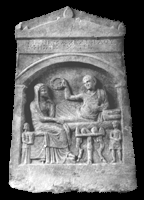Religion and
Death

The Greek View of
Death
Greeks believed that when a person died, his or her vital breath or psyche left the body to enter the palace of Hades, king of the dead. The psyche, once it had fled the body existed merely as a phantom image, which you could sense but not touch. The wall separating the living from the dead was virtually impenetrable.
The idea of punishments for the wicked and rewards for the good did not at first exist. But later, various secret mystery cults began to promise their members a state of blessedness after death. At the same time they thought sinners deserved everlasting punishment.
From an early time, concerns about what happened
after death gave rise to a number of burial rituals.
 Western
Asia Minor Marble Funeral Stele
Western
Asia Minor Marble Funeral SteleHellenistic/1st century BC
MS 4023
A man reclines in an arched niche on a tall dining couch or kline. Leaning on his left elbow supported by a pillow, he holds aloft a funeral wreath. A woman, probably his wife, is shown in an attitude of contemplation with her cloak or himation pulled over her head. The three-legged table is laden with food. Male and female servants, done in a smaller scale in keeping with their lesser status, fill out the remainder of this melancholy scene. The inscription across the architrave reads "Worthy Menemachos, son of Diphilos, farewell."
H. 70.5; W. 47.0; Th. 8.5 cm. UM neg. NC35-3317. (large version)
The Ancient Greek World Index